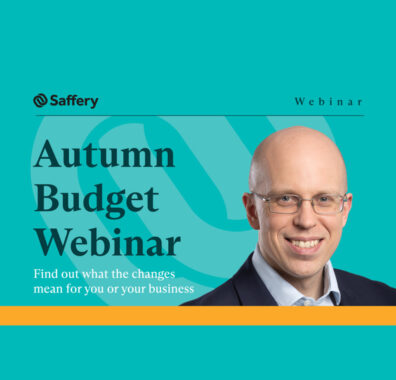Autumn Budget 2025: What NIC changes could mean for professional services firms

Update: Our latest understanding is that the Chancellor has dropped plans to introduce National Insurance Contributions on partnership and limited liability partnership (LLP) profits, after Treasury modelling suggested that it would cost the government more than it would raise. While this proposal now appears to be off the table, please contact us if you want to review your firm’s structure, tax compliance or strategic planning.
Speculation has been growing recently that Rachel Reeves might use Autumn Budget 2025 to introduce National Insurance Contributions (NICs) on partnership profits, including those of limited liability partnerships (LLPs). Such a move could have significant implications for professional practices, including those in the financial services sector.
Suggested NIC changes
Currently self-employed individuals, including partners in partnerships and LLPs, pay Class 4 NICs on their profit shares. For the 2025-26 tax year, this is 6% on profits between £12,570 and £50,270, and 2% on profits above that. By comparison, employees pay Class 1 NICs at 8% on earnings between £12,570 and £50,270, and 2% above that. However, these are both ‘employee-side’ NICs. The key difference is that, in addition, employers pay a further 15% employer NICs on employees’ salaries above £5,000, whereas there is currently no equivalent charge on partnership profits. The rumoured reform would introduce a new ‘partnership NIC’ to more closely align the ‘employer-side’ NICs. As it’s only speculation at this point, we don’t have more details, such as whether:
- The change would apply to LLPs only or traditional partnerships too,
- The rate would match employer NICs, or if there would be an allowance (like the current £10,500 employment allowance) to protect the smallest partnerships, and
- The NICs would be charged on profits, drawings or another basis.
Research published last month by the Centre for the Analysis of Taxation Policy (CenTax) suggests such a reform could raise around £1.9 billion per year, with 98% of the revenue coming from individuals in the top 10% by total income. The report also provides useful context on which industries and regions would be most affected. The legal and financial sectors stand out as the most significantly impacted, with solicitors accounting for about 20% of all partnership income and about 95% of them expected to be affected. Partners in financial services, particularly those in activities auxiliary to financial services, also face a high impact, with average profits per partner being £675,000.
Other affected industries include accounting and auditing, general medical practice, and patent/copyright agents. By contrast, sectors such as mixed farming have much lower average profits, and may not be affected at all if an allowance is introduced.
If the changes are announced in the Budget, they could take effect immediately or from April 2026.
Why not join Adam Kay for our Autumn Budget Webinar on Thursday 27 November, from 8.30am to 9.30am, to help you understand the implications of the Chancellor’s announcements?
What’s an LLP?
It’s been possible to set up an LLP in the UK since April 2001. They offer a hybrid structure, with some of the benefits and obligations of both partnerships limited companies. LLPs are separate legal entities, so they can own assets and enter contracts, while the liability of its partners (or more correctly members) is generally limited to their capital contribution. For tax, like partnerships, LLPs are transparent, so members are taxed individually on their share of profits, not the LLP itself. LLPs come with greater setup costs, filing obligations and public disclosure than ordinary partnerships.
Why now?
There’s widespread expectation that Reeves will need to raise taxes in the Budget on 26 November 2025 to help fill an estimated £20-£30 billion fiscal deficit. She has indicated that higher taxes on the wealthy will be “part of the story”. The idea for introducing NICs on partners’ profit shares has been put forward by think tanks such as CenTax and the Resolution Foundation.
While the suggested change focuses on the perceived ‘tax break’ for partners in LLPs and partnerships, there are other considerations. Many professional services firms choose these structures for commercial and operational reasons, such as flexibility, profit-sharing, and aligning ownership with management – not just for tax. It’s also worth noting that the taxable profit figure is not simply the cash available to partners, as many business expenses are not allowable for tax, so the amount taxed can be higher than the actual funds distributed or retained for business needs.
Practical implications for professional practices
If partnership NICs are introduced, it will increase the NICs burden on partners in partnerships and LLPs. Depending on the detailed rules any profit share and/or drawings paid to partners could be subject to the new NIC charge, reducing the net amount partners receive. This means partnerships will need to factor in the additional NICs when planning distributions and may need to reconsider how and when profits are allocated to ensure cash flow and tax efficiency.
The introduction of partnership NICs would not only affect individual partners but could also reduce the overall profit ‘pot’ available for reinvestment in the business. This may have wider consequences, such as reducing the amount available for growth and development, prompting firms to review their cost base. In professional practices, where people are the main cost, this could impact hiring and wage growth for employees.
Currently, partners pay NICs at lower rates than employees, but do not receive the same employment benefits. For example, partners are not entitled to statutory sick pay, holiday pay, redundancy pay, or employer pension contributions, and they do not have the same protections against unfair dismissal, which employees benefit from.
The potential introduction of partnership NICs may reignite debate about the attractiveness of partnership and LLP structures compared to a corporate structure and it’s possible firms may want to consider incorporation.
What action can professional practices take?
- Consider accelerating the distribution of profits to before the Budget (subject to cashflow).
- Review partnership agreements to check what they say regarding drawings calculations especially for fixed share partners.
- Assess the financial impact on future profit shares, cash flow, and investment plans.
- Review your firm’s structure to check it’s still appropriate.
- Communicate with partners about the possible changes.
How we can help
At Saffery, our Professional Practices Team has considerable experience advising professional services firms on structuring, tax compliance, and strategic planning. We can help you assess what the potential changes would mean for you and how you can navigate the impact.
Disclaimer
This article discusses the potential impact of the Autumn Budget 2025 on professional services firms. At the date of publication, the Budget changes have not been announced. Acting on the basis that anticipated future tax changes will be implemented could lead to adverse financial consequences. Readers should not rely on this information as financial or legal advice. For guidance tailored to your specific circumstances, please consult a qualified professional.
More on Autumn Budget 2025
Contact us
Partner, London
Key experience





